|
Stations on the Emmitsburg Railroad
Phyllis Ibach Hawkins
Only 7.3 miles long, the Emmitsburg Railroad, a branch of the
Western Maryland Railroad, nonetheless honored seven station stops. Each had at least
a "shack." although not necessarily a platform. Rocky Ridge had a station with a ladies' waiting room, and at Motters Station there was what was called a hotel
where you could board for a few days and join the nightly gamesws and snacks in the store once it was closed.
In its more or less 65 years of service (1875-1940) the "Dinky," as it was more commonly known, took young children to their
classrooms each day (where some lads have confessed being more interested in what was happening over on the tracks they could see through the window than what
the good teacher Mrs. Mary Smith Scott was trying to convey). Young men rode it to Mount Saint Mary's College. and young women took it to and from
Saint Joseph's College founded by the Sisters of Charity who were the major stockholders of the
Emmitsburg Railroad. As its freight it carried cattle, coal, milk, grain, lumber, and once, two carloads of lemons.
In this first of what, is planned as little vignettes of the Emmitsburg Railroad, the seven stations will be featured. The
second will have an overview and what pictures are available of the rolling stock, featuring the eight locomotives and one gasoline Universal Motor Car. Perhaps
a third on its oddities, happenings and personalities will follow. The emphasis will be on the "romance" of the road, rather than trying to present any
definitive treatise on the subject. Any stories or historical information readers would like to contribute would be most welcome. These items will be shared
with the Archives at both Mount Saint Mary's College and Saint Joseph's Provincial House as well as becoming part of the Western Maryland Railway Historical
Society's permanent collection. Pictures of some of the Emmitsburg Railroad memorabilia from the collection of Joseph and
Catherine Marsden, granddaughter of
Vincent Sebold, long-time ERR General Manager, and niece of Louise Sebold, the last
Secretary-Treasurer, will be interspersed.
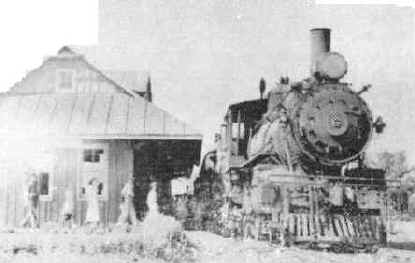 1. Emmitsburg: The northern terminus for
freight and passengers was the Emmitsburg station, which seems to have been an ordinary, good-sized station. although it was described by one author as
"pretentious."' It was just across the creek from where the post office is today. Guy Baker Sr. the station master for many years. 1. Emmitsburg: The northern terminus for
freight and passengers was the Emmitsburg station, which seems to have been an ordinary, good-sized station. although it was described by one author as
"pretentious."' It was just across the creek from where the post office is today. Guy Baker Sr. the station master for many years.
 A Baltimore Sun reporter interviewing some of the
Emmitsburg citizenry on August 29. 1940, the day after the railroad was sold at auction for $14,600's, found one former employee, Leslie Fox. operating a
filling station on the railroad property in front of the station and Harry Wantz, the former engineer, running an automobile repair shop on the grounds. The
station at the time was said to be in good repair, but the shed where the locomotive was housed had large holes in its roof. A Baltimore Sun reporter interviewing some of the
Emmitsburg citizenry on August 29. 1940, the day after the railroad was sold at auction for $14,600's, found one former employee, Leslie Fox. operating a
filling station on the railroad property in front of the station and Harry Wantz, the former engineer, running an automobile repair shop on the grounds. The
station at the time was said to be in good repair, but the shed where the locomotive was housed had large holes in its roof.
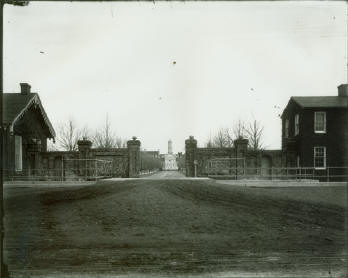 |
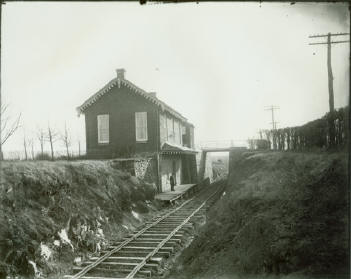 |
2. St. Joseph's College: The Academy
station featured a red railroad depot and a Porter's Lodge elevated at opposite ends of the colonial brick wall supporting the wrought-iron gates framing the
entrance to the Avenue. Sister Mary Bernard McEntee in the valley, published for the 75 Anniversary of the St. Joseph's College Alumnae Association (1972)
describes the three mournful blast of Dinky's whistle as it crossed the trestle over Tom's Creek, then it whoofed and pulled to a grinding stop. Meeting Dinky
was one the social events of commencement week. Students sometimes, she also reported walked on the tracks to get into the village unobserved.
The Annals of the community tell the story of a dangerous fire on October 13, 1909: A configuration at St. Joseph's today. The
station was discovered on fire at five, p.m.; it is supposed that it caught fire from a spark off the training passing, either at three of four o'clock.
All the men belonging to Joseph's were on the spot in a few minutes; it is said that all men from Emmitsburg came over also working for nearly two hours, thus
preventing greater damage, for if the gate house and trees had caught, the main house would have been in danger. The fire was under control before seven o'clock, but three men were left watching, a good thing, as the fire started again during the night but was extinguished immediately.
The station and lodge remained for some years after passenger service stopped, finally disappearing when the "wailing wall" was
demolished in 1945.
3. Dry Bridge (Mount Saint Mary's College): The Dry Bridge Station was to the east of where the Mount's playing fields
on Dry Bridge Road in the direction of Keysville road. A good potion of the roadbed is still visible and used as the a drive way to the Reaver Woodworking
shop.
4. Motter's Station:
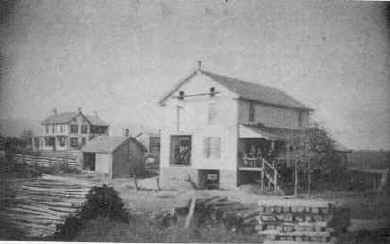
The wonderful pictures hanging over Bob and Banche Sayler's kitchen table shows the excitement surrounding the
1883 construction of the house they live in on
Motter's Station Road Station Road and the buildings housing the businesses of the station. The complex was built by Ike Fisher who lived there and
ran the store, hotel with a tavern, a creamery, and the livery, etc·, from 1883 to 1916. Everyone who worked at the station was boarded there. Salesmen came in
on the train and stayed here, too, taking buggies out into the country to hawk their wares. In 1916 the complex was purchased by James M. Sayler who had the
business until 1946.
He had baled hay for Mr. Fisher at one cent per bale (considered good money) and met his wife there while she was working for
Mr. Fisher's housekeeper. Mr. Sayler had the store, feed business, and sold farm machinery. During the Depression the hotel building had been turned into the
feed house, although the letter "B" with "R" missing remains in one of the windows revea1ing its former existence. Bob, his son, ran the store from the time he
was 13 years old (1934) while his father ran the rest of the operation, which included making ice cream for festivals and other occasions. Bob took over in
1946, built a new store in 1957, and finally retired in 1982. The store would close at 9 p.m., Bob says, and out would come the crackers and cheese, the
checkers and dominoes.
 Pop was the drink of choice as the senior the mayor would allow no
alcohol on the premises. Bob's tells you they had some wonderful times in that store. He relates how the Western Maryland would keep the rails clear of
snow—except in 1936 when was among those digging the cuts out twice—one 18 feet deep! Bob was one of those kids who rode the train to the Emmitsburg School and
one of the boys who would sneak out the cloakroom window to run and see what was going on at the station. Bob tells how Maurice Keilholtz, the conductor for
many years, carried a shotgun on the train and would pull the rip cord to stop the train so he could get rabbits. Pop was the drink of choice as the senior the mayor would allow no
alcohol on the premises. Bob's tells you they had some wonderful times in that store. He relates how the Western Maryland would keep the rails clear of
snow—except in 1936 when was among those digging the cuts out twice—one 18 feet deep! Bob was one of those kids who rode the train to the Emmitsburg School and
one of the boys who would sneak out the cloakroom window to run and see what was going on at the station. Bob tells how Maurice Keilholtz, the conductor for
many years, carried a shotgun on the train and would pull the rip cord to stop the train so he could get rabbits.
5. Ridgeway Station: This was just a stop on the line for drops and pickups.
6. Appolds: This was just a stop on the line for drops and pickups.
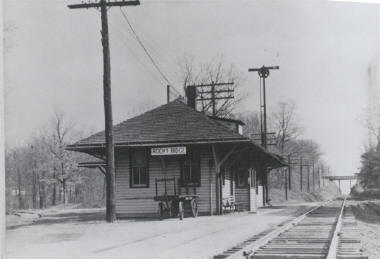 7. Rocky Ridge - Emmitsburg Junction: As
the plans for renovating the Station at Rocky Ridge show, it was a complete facility with even the added luxury of a ladies' waiting room. According to a
Western and Maryland Railway Company Authority for Expenditure dated May 24, 1923, a 15-foot freight room was to be converted into a women's waiting room with
an additional 'toilet room' because, "St. Joseph's college made a complaint to the Maryland Public Service Commission that the present facilities were
inadequate ..." 7. Rocky Ridge - Emmitsburg Junction: As
the plans for renovating the Station at Rocky Ridge show, it was a complete facility with even the added luxury of a ladies' waiting room. According to a
Western and Maryland Railway Company Authority for Expenditure dated May 24, 1923, a 15-foot freight room was to be converted into a women's waiting room with
an additional 'toilet room' because, "St. Joseph's college made a complaint to the Maryland Public Service Commission that the present facilities were
inadequate ..."
 The story is told that Mount basketball teams sometimes spent snowed-in evenings in the station. There was a wye as well
as a turntable at Rocky ridge, the southern terminus of the branch line and the junction with the Western Maryland. trains had to back up to Emmitsburg on
the single track. According to a letter to WM General Superintendent Merric dated May , 1913, more the 100 feet of the track on the east leg of the wye
was owned and kept up by the ERR, "the upkeep of the balance being care of by the Western Maryland. On the other hand, the west leg of the wye is maintained
entirely by them." ERR General Manager Sebold apparently had no objection to WM's use of the wye, but wanted 90-lb. rail used as he considered the 70-lb. too,
light. "He also thought something should be done to put in a warehouse track as the present wye is being used entirely too much and greatly inconveniences the
movement of their engine." The story is told that Mount basketball teams sometimes spent snowed-in evenings in the station. There was a wye as well
as a turntable at Rocky ridge, the southern terminus of the branch line and the junction with the Western Maryland. trains had to back up to Emmitsburg on
the single track. According to a letter to WM General Superintendent Merric dated May , 1913, more the 100 feet of the track on the east leg of the wye
was owned and kept up by the ERR, "the upkeep of the balance being care of by the Western Maryland. On the other hand, the west leg of the wye is maintained
entirely by them." ERR General Manager Sebold apparently had no objection to WM's use of the wye, but wanted 90-lb. rail used as he considered the 70-lb. too,
light. "He also thought something should be done to put in a warehouse track as the present wye is being used entirely too much and greatly inconveniences the
movement of their engine."
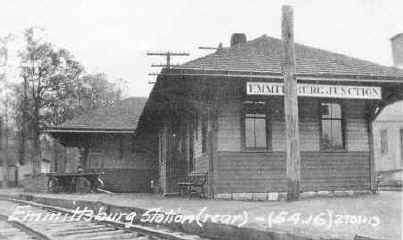 A larger controversy erupted over Sebold's role in
the ERR'. changing of the name of the station from Rocky Ridge to Emmitsburg Junction on July 5, 1913. The post office remained Rocky Ridge. WM President J. M.
Fitzgerald must have complained that he had not been consulted about the change because General Superintendent Merrick wrote him on August 4 that, "I will see
that your office is consulted on all cases of this kind in the future." A new General Superintendent Ennes explained to new President C. R. Gray on March 30,
1914, that, this was done. . . quite likely from a passenger standpoint, as they wanted passengers to understand that Emmitsburg Junction was the point at which
they would take and leave the train for Emmitsburg." A larger controversy erupted over Sebold's role in
the ERR'. changing of the name of the station from Rocky Ridge to Emmitsburg Junction on July 5, 1913. The post office remained Rocky Ridge. WM President J. M.
Fitzgerald must have complained that he had not been consulted about the change because General Superintendent Merrick wrote him on August 4 that, "I will see
that your office is consulted on all cases of this kind in the future." A new General Superintendent Ennes explained to new President C. R. Gray on March 30,
1914, that, this was done. . . quite likely from a passenger standpoint, as they wanted passengers to understand that Emmitsburg Junction was the point at which
they would take and leave the train for Emmitsburg."
Vincent Sebold's response to General Passenger Agent C. F. Stewart on February 28, 1914, defended his actions after complaints
came in about confusion in billing between Emmitsburg and now Emmitsburg Junction. He said of one complainant that the "gentleman. . . had not farmed since he
was a boy and since then has done little else except warm the seats at the station." Another complainant made cigar boxes in a small way, a few of which he
ships." He concludes, "I regret you have this annoyance but from the great convenience the change is to your patrons whose business is worth thousands of
dollars to you in the course of the year, it certainly seems unreasonable to change again." "After examining the matter [sic] feel I can draw only one
conclusion that the objections are founded more on sentiment than the inconvenience of the public."
A typed overview of the Emmitsburg Railroad by an unknown author and probably written about 1910 sums it up fairly well: "The
road is only seven miles in length and always was and is now almost entirely owned by local people. While it is small it is of great importance to the community
and gives more train service than any other road of its size in the State
Read George Wireman's
History of the Emmitsburg Railroad
Have your own memories of the Emmitsburg Railroad?
If so, send them to us at history@emmitsburg.net
|